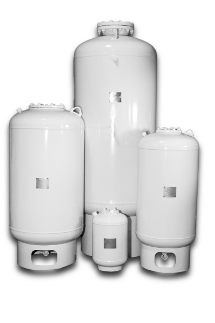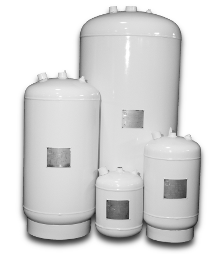Thermal Expansion - Domestic Hot Water Tanks
 Thermal expansion tanks are designed for pressure control in potable water systems. The building’s water heater or water heating system typically creates thermally expanded water. A properly sized thermal expansion tank will accommodate this additional volume of water through expansion during the heating cycle and control the system pressure increases, keeping pressures from reaching critical limits. The tank uses compressed air to maintain system pressures by accepting and expelling the changing volume of water as it heats and cools. These tanks are designed using a flexing Butyl barrier that separates the stored water from the captured pressure control air cushion. This barrier, a replaceable bladder or fixed diaphragm, allows the water to be contained within the bladder preventing corrosion and potential water logging. The thermal expansion tanks are engineered to meet ASME standards, and are also available in non-code designs. Wessels thermal expansion tanks are offered in industry’s broadest range from 2 to 4,000 gallons and up to 250 PSI.
Thermal expansion tanks are designed for pressure control in potable water systems. The building’s water heater or water heating system typically creates thermally expanded water. A properly sized thermal expansion tank will accommodate this additional volume of water through expansion during the heating cycle and control the system pressure increases, keeping pressures from reaching critical limits. The tank uses compressed air to maintain system pressures by accepting and expelling the changing volume of water as it heats and cools. These tanks are designed using a flexing Butyl barrier that separates the stored water from the captured pressure control air cushion. This barrier, a replaceable bladder or fixed diaphragm, allows the water to be contained within the bladder preventing corrosion and potential water logging. The thermal expansion tanks are engineered to meet ASME standards, and are also available in non-code designs. Wessels thermal expansion tanks are offered in industry’s broadest range from 2 to 4,000 gallons and up to 250 PSI.
Pressurized thermal expansion tanks differ from plain steel expansion tanks in that a flexible bladder or diaphragm separates the air cushion from the system fluid. The air side pre-charge of the tank must be field adjusted to equal the system supply pressure. As the system water expands, the bladder expands open, pushing against the air cushion to accept the expanded water.
 Thermal Expansion Bladder Tanks (ASME / NON-ASME)
Thermal Expansion Bladder Tanks (ASME / NON-ASME)
Bladder tanks are required in a closed-loop heating or chilled water HVAC system to absorb the expanding fluid and limit the pressure within a heating or cooling system. A properly sized expansion or compression tank will accommodate the expansion of the system fluid during the heating or cooling cycle without allowing the system to exceed the critical pressure limits of the system.
Divider
 Thermal Diaphragm Tanks (ASME / NON-ASME)
Thermal Diaphragm Tanks (ASME / NON-ASME)
The diaphragm tank has been developed to allow the systems air cushion to be separated from the systems water. No waterlogging of the tank can occur as the air is held between the tank wall and the outside of a bladder placed inside the tank, while the system water is contained inside the bladder. This changes the system to an air elimination system, as any air extracted from the system water is passed out of the system into the atmosphere.

